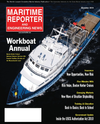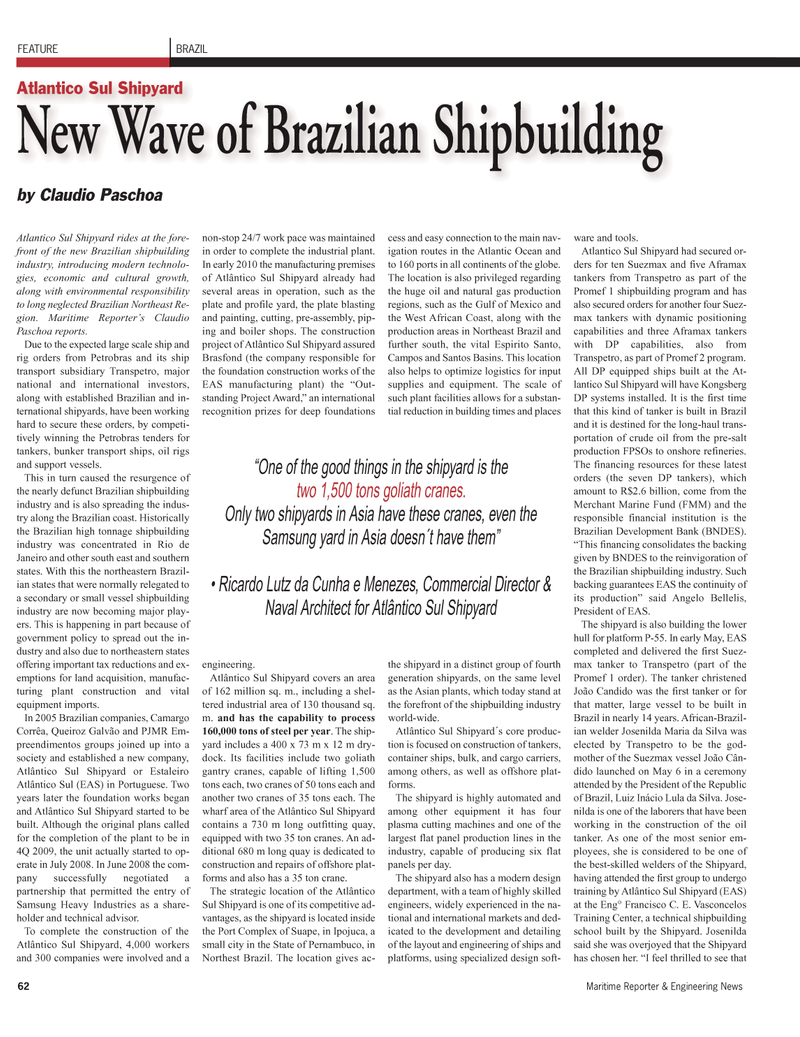
Page 64: of Maritime Reporter Magazine (November 2010)
Workboat Annual
Read this page in Pdf, Flash or Html5 edition of November 2010 Maritime Reporter Magazine
62 Maritime Reporter & Engineering News
Atlantico Sul Shipyard rides at the fore- front of the new Brazilian shipbuilding industry, introducing modern technolo- gies, economic and cultural growth, along with environmental responsibility to long neglected Brazilian Northeast Re- gion. Maritime Reporter’s Claudio
Paschoa reports.
Due to the expected large scale ship and rig orders from Petrobras and its ship transport subsidiary Transpetro, major national and international investors, along with established Brazilian and in- ternational shipyards, have been working hard to secure these orders, by competi- tively winning the Petrobras tenders for tankers, bunker transport ships, oil rigs and support vessels.
This in turn caused the resurgence of the nearly defunct Brazilian shipbuilding industry and is also spreading the indus- try along the Brazilian coast. Historically the Brazilian high tonnage shipbuilding industry was concentrated in Rio de
Janeiro and other south east and southern states. With this the northeastern Brazil- ian states that were normally relegated to a secondary or small vessel shipbuilding industry are now becoming major play- ers. This is happening in part because of government policy to spread out the in- dustry and also due to northeastern states offering important tax reductions and ex- emptions for land acquisition, manufac- turing plant construction and vital equipment imports.
In 2005 Brazilian companies, Camargo
Corrêa, Queiroz Galvão and PJMR Em- preendimentos groups joined up into a society and established a new company,
Atlântico Sul Shipyard or Estaleiro
Atlântico Sul (EAS) in Portuguese. Two years later the foundation works began and Atlântico Sul Shipyard started to be built. Although the original plans called for the completion of the plant to be in 4Q 2009, the unit actually started to op- erate in July 2008. In June 2008 the com- pany successfully negotiated a partnership that permitted the entry of
Samsung Heavy Industries as a share- holder and technical advisor.
To complete the construction of the
Atlântico Sul Shipyard, 4,000 workers and 300 companies were involved and a non-stop 24/7 work pace was maintained in order to complete the industrial plant.
In early 2010 the manufacturing premises of Atlântico Sul Shipyard already had several areas in operation, such as the plate and profile yard, the plate blasting and painting, cutting, pre-assembly, pip- ing and boiler shops. The construction project of Atlântico Sul Shipyard assured
Brasfond (the company responsible for the foundation construction works of the
EAS manufacturing plant) the “Out- standing Project Award,” an international recognition prizes for deep foundations engineering.
Atlântico Sul Shipyard covers an area of 162 million sq. m., including a shel- tered industrial area of 130 thousand sq. m. and has the capability to process 160,000 tons of steel per year. The ship- yard includes a 400 x 73 m x 12 m dry- dock. Its facilities include two goliath gantry cranes, capable of lifting 1,500 tons each, two cranes of 50 tons each and another two cranes of 35 tons each. The wharf area of the Atlântico Sul Shipyard contains a 730 m long outfitting quay, equipped with two 35 ton cranes. An ad- ditional 680 m long quay is dedicated to construction and repairs of offshore plat- forms and also has a 35 ton crane.
The strategic location of the Atlântico
Sul Shipyard is one of its competitive ad- vantages, as the shipyard is located inside the Port Complex of Suape, in Ipojuca, a small city in the State of Pernambuco, in
Northest Brazil. The location gives ac- cess and easy connection to the main nav- igation routes in the Atlantic Ocean and to 160 ports in all continents of the globe.
The location is also privileged regarding the huge oil and natural gas production regions, such as the Gulf of Mexico and the West African Coast, along with the production areas in Northeast Brazil and further south, the vital Espirito Santo,
Campos and Santos Basins. This location also helps to optimize logistics for input supplies and equipment. The scale of such plant facilities allows for a substan- tial reduction in building times and places the shipyard in a distinct group of fourth generation shipyards, on the same level as the Asian plants, which today stand at the forefront of the shipbuilding industry world-wide.
Atlântico Sul Shipyard´s core produc- tion is focused on construction of tankers, container ships, bulk, and cargo carriers, among others, as well as offshore plat- forms.
The shipyard is highly automated and among other equipment it has four plasma cutting machines and one of the largest flat panel production lines in the industry, capable of producing six flat panels per day.
The shipyard also has a modern design department, with a team of highly skilled engineers, widely experienced in the na- tional and international markets and ded- icated to the development and detailing of the layout and engineering of ships and platforms, using specialized design soft- ware and tools.
Atlantico Sul Shipyard had secured or- ders for ten Suezmax and five Aframax tankers from Transpetro as part of the
Promef 1 shipbuilding program and has also secured orders for another four Suez- max tankers with dynamic positioning capabilities and three Aframax tankers with DP capabilities, also from
Transpetro, as part of Promef 2 program.
All DP equipped ships built at the At- lantico Sul Shipyard will have Kongsberg
DP systems installed. It is the first time that this kind of tanker is built in Brazil and it is destined for the long-haul trans- portation of crude oil from the pre-salt production FPSOs to onshore refineries.
The financing resources for these latest orders (the seven DP tankers), which amount to R$2.6 billion, come from the
Merchant Marine Fund (FMM) and the responsible financial institution is the
Brazilian Development Bank (BNDES). “This financing consolidates the backing given by BNDES to the reinvigoration of the Brazilian shipbuilding industry. Such backing guarantees EAS the continuity of its production” said Angelo Bellelis,
President of EAS.
The shipyard is also building the lower hull for platform P-55. In early May, EAS completed and delivered the first Suez- max tanker to Transpetro (part of the
Promef 1 order). The tanker christened
João Candido was the first tanker or for that matter, large vessel to be built in
Brazil in nearly 14 years. African-Brazil- ian welder Josenilda Maria da Silva was elected by Transpetro to be the god- mother of the Suezmax vessel João Cân- dido launched on May 6 in a ceremony attended by the President of the Republic of Brazil, Luiz Inácio Lula da Silva. Jose- nilda is one of the laborers that have been working in the construction of the oil tanker. As one of the most senior em- ployees, she is considered to be one of the best-skilled welders of the Shipyard, having attended the first group to undergo training by Atlântico Sul Shipyard (EAS) at the Eng° Francisco C. E. Vasconcelos
Training Center, a technical shipbuilding school built by the Shipyard. Josenilda said she was overjoyed that the Shipyard has chosen her. “I feel thrilled to see that
BRAZILFEATURE
Atlantico Sul Shipyard
New Wave of Brazilian Shipbuilding by Claudio Paschoa “One of the good things in the shipyard is the two 1,500 tons goliath cranes.
Only two shipyards in Asia have these cranes, even the
Samsung yard in Asia doesn´t have them” • Ricardo Lutz da Cunha e Menezes, Commercial Director &
Naval Architect for Atlântico Sul Shipyard

 63
63

 65
65
